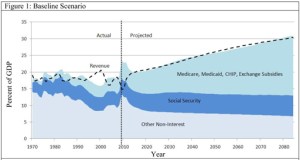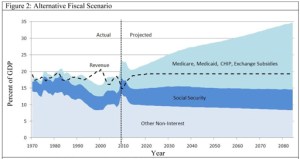The Congressional Budget Office’s budgetary scoring of the health reform law has returned as a subject of debate. At issue is whether health reform will really reduce the deficit by $143 billion through 2019 as the CBO predicted last year. It’s a legitimate question, but focusing on it misses the most important message conveyed by CBO estimates.
Republicans in the House, who are intent to repeal the new health law, contend that eliminating it wouldn’t really increase the deficit. It’s an argument that makes sense if one is willing to reject the CBO’s deficit-reducing score of the law, and many are. There are good reasons to be skeptical that the law will in fact reduce the deficit.
The CBO recognized this and produced not one, but two long-term projections of the overhaul’s impact. Using CBO data, I depict their so-called “baseline scenario” in Figure 1, below. It shows actual and predicted federal government revenue and spending from 1970 through 2085.
Under the baseline scenario, deficits are negative or very small from 2015 through 2085. However, to accomplish this balancing of the books, government revenue (taxes) must increase dramatically to keep pace with the growth in spending on health care programs. In fact, tax receipts must roughly double in the next 75 years, growing well beyond the stable postwar level, which has been below about 20.5 percent of the gross domestic product in all years since 1945. By the way, don’t assume that the growth in health care costs depicted in the figure is due to health reform. It was predicted at about the same level several years before reform passed.

Note: Figures exclude interest on the national debt.
Source: Author’s graph of Congressional Budget Office data.
Perhaps Americans will be amenable to supplying ever greater revenue to the federal government. After all, tax rates are far higher in many other OECD countries. But I’m skeptical that America will stand for it. The CBO was, too, so they produced a second forecast called the “alternative fiscal scenario.” The long-term implications of it are depicted in Figure 2, below.

Note: Figures exclude interest on the national debt.
Source: Author’s graph of Congressional Budget Office data.
In the alternative fiscal scenario, the CBO assumed that tax revenue would eventually flat-line at about 19 percent of GDP, not far from the historical average. Additionally, they assumed that many of the cost control features of the new health reform law would not be as effective as assumed in the baseline scenario. Thus, deficits grow ever larger due to even faster growing health care costs and constant revenue levels. Deficits would likely grow about as rapidly if health reform were repealed too.
Here’s the state of the debate over these CBO health-reform estimates: which is right, the baseline scenario or the alternative fiscal scenario? It’s the wrong question! It doesn’t matter which scenario you think is right. Likely neither is when examined in any detail, and both are horrible in broad sweep. Choose your poison: massive taxation or massive debt.
Actually, though, there’s a third option: recognition of the underlying problem and dealing with it.
The problem is health care costs. They’ll cause budgetary distress with or without health reform. The CBO’s estimates, both of them, show it clearly. Health care costs have been the source of budgetary woes for decades, and there’s no end in sight under any realistic scoring of any serious health reform proposal.
Proposals that simply declare that rates of Medicare spending cannot exceed economic growth by a certain amount are not credible unless they also suggest a mechanism by which such spending growth targets will be achieved. Any such mechanism, to be believed, must escape the forces that have caused prior cost control efforts to fail, including congressional meddling driven by the interests of key stakeholders.
One way to get serious is to embrace the cost control provisions of the new law and to protect them from the likely efforts of future policymakers to undo them. In this, I agree with health economist Henry Aaron, who wrote about the health reform law,
[T]he bill contains, at least in embryonic form, virtually every idea for cost control that any analyst has come up with. The most practical cost-control strategy that is now available to Congress is to accelerate the implementation of these provisions, not to stymie them.
That is, the cost controls on the books should be strengthened, not repealed or demagogued. We need them to work, and to work even better than shown in Figure 1. Changes to Medicare and Medicaid payment systems, the Cadillac tax and the creation of the Independent Payment Advisory Board can all be effective tools to reduce federal, state and private health care costs — if used wisely and to their fullest.
It won’t be easy, and more laws may need to be passed to give government programs and private insurers additional cost-cutting tools. With each proposal to do so, the CBO may be asked to predict the consequences. When they do, don’t just listen to how politicians and pundits debate the anticipated effect on deficits, but also look closely at the rate of health care cost growth. If the projections look like either Figures 1 or 2 above, CBO is still telling us we’re in trouble. Will anyone quiet down long enough to listen? More importantly, are we willing to do something about it?
Austin Frakt is a health economist and an Assistant Professor of Health Policy and Management at Boston University’s School of Public Health. He blogs at The Incidental Economist.






